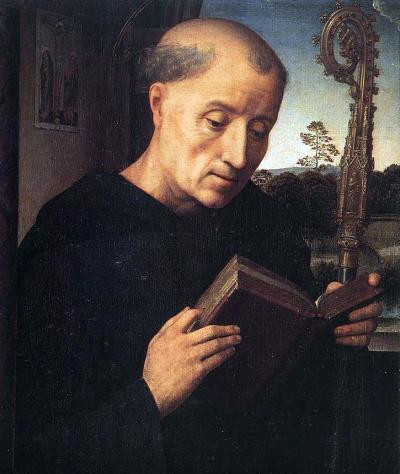
Saint of the Day for 11 July: Saint Benedict of Norcia
The spiritual father of Europe
Name
Saint Benedict of Norcia
Title
Abbot, patron of Europe
Birth
480, Norcia
Dead
21 March 547, Monte Cassino, Frosinone
Recurrence
11 July and 21 March
Martyrology
2004 edition
Prayer
To you today we address our ardent supplication, glorious Saint Benedict, “messenger of peace, realiser of unity, master of civilisation, herald of the religion of Christ”, and we implore your protection on individual souls, on the monasteries that follow your holy Rule, on Europe, on the entire world. Teach us again the primacy of divine worship, grant that we may understand how great and fruitful is the gift of peace, help all those who strive to recompose the spiritual unity of the various peoples, broken by so many painful events, so that through your protection we may all return to being brothers in Christ. Amen.
Patron of
Pomezia, Cassino, Pontecagnano Faiano, Scorzè, Cetraro, Subiaco, Gonzaga, San Benedetto Po, Norcia, San Benedetto Val di Sambro
The Saint and Mission
St Benedict of Norcia was a shining example of how mission can be achieved through the pursuit of holiness in daily life. His monastic rule and teaching have had a lasting impact on the Church and Christian spirituality.
St Benedict’s mission was based on the idea of seeking God in all things and living in communion with Him through prayer, work and obedience. He founded monasteries in which the pursuit of holiness and the cultivation of virtues such as discipline, stability and humility were central.
His mission also extended beyond the monasteries, influencing the surrounding society. St Benedict encouraged his monks to be hospitable and charitable to the poor and strangers, thus spreading the love of God through hospitality and generosity.
The figure of St Benedict reminds us that mission is not just a task reserved for a few, but an invitation addressed to all Christians. Each of us can seek holiness in our own lives, bearing witness to our faith through our daily actions and service to others.
His legacy continues to inspire and guide the faithful today, inviting them to live according to the principles of his monastic rule and to engage in the mission of transforming the world with God’s love.
The Saint and Mercy
St Benedict of Norcia is a saint venerated by the Catholic Church and considered one of the founding fathers of Western monasticism. During his lifetime, St. Benedict did many works of mercy, but his most significant contribution to education was through the establishment of Benedictine monasteries.
Thus, although St. Benedict did not specifically mention the education of the ignorant as a work of mercy, his work in founding the Benedictine monasteries and promoting education certainly had a lasting impact on the education of people and the spread of knowledge in medieval Europe.
Founder of
St Benedict founded the monastery of Monte Cassino, which became the spiritual and cultural centre of Western Europe in the Middle Ages. Benedictine monasteries were places of prayer, study and work, where monks devoted themselves to the search for truth, the preservation of knowledge and the education of community members and people who came to them seeking instruction.
Benedictine monks were engaged in teaching the liberal arts, such as grammar, rhetoric, logic, music, arithmetic, geometry and astronomy. They also promoted the reading and copying of ancient texts, thus contributing to the preservation and dissemination of classical culture. Benedictine monasteries became important centres of learning and their libraries preserved precious manuscripts that would otherwise have been lost.
The education of monks and lay people who attended the monasteries was based on principles such as humility, discipline, manual labour and love of study. Benedictine monks saw themselves as custodians of knowledge and were committed to passing it on to future generations. In this way, they contributed significantly to the formation of minds and the education of the people who sought their guidance.
Hagiography
S. Benedict, father of Western monasticism, restorer of the Christian spirit of his time, was born in Norcia, Umbria, of the noble Anicia family in 480. Sent to Rome to study liberal disciplines, he soon withdrew from the world. He took up residence in the hollow of Subiaco, where he remained hidden and unknown to all for three years, leading a penitent and angelic life. As the fame of his holiness spread, some monks placed themselves under his wise and enlightened guidance. But his conduct was a constant reproach and a stark contrast to their relaxed life. Unwilling to submit to his admonitions, they tried to poison him: but when he made, as was his custom, the sign of the cross, the glass presented to him broke.
Then our saint withdrew again into solitude, and as a great number of disciples came to him, he had to build twelve monasteries. He then moved to Monte Cassino, where, having torn down the statue of Apollo, he founded that famous monastery, a marvel of beauty and art, from which the first Benedictine apostles departed. Here he created his well-known rule in which he…
Read Also
Saint of the Day for 10 July: Saints Rufina and Seconda
Saint of the Day for 09 July: Saint Veronica Giuliani
Saint of the Day for 08 July: Saints Aquila and Priscilla
Saint of the Day for 07 July: Blessed Benedict XI
Saint of the Day for 06 July: Maria Teresa Ledóchowska
